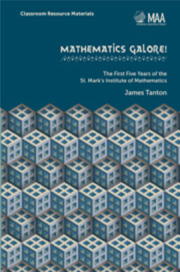Book contents
- Frontmatter
- Contents
- Introduction
- Newsletters and Commentaries
- Appendices
- I Numbers that are the Sum of Two Squares
- II Pick's Theorem
- III The Möbius Function
- IV The Borsuk-Ulam Theorem
- V The Galilean Ratios
- VI A Candy-Sharing Game
- VII Bending Buffon's Needle
- VIII On Separating Dots
- Index of Topics
- Classic Theorems Proved
- About the Author
III - The Möbius Function
from Appendices
- Frontmatter
- Contents
- Introduction
- Newsletters and Commentaries
- Appendices
- I Numbers that are the Sum of Two Squares
- II Pick's Theorem
- III The Möbius Function
- IV The Borsuk-Ulam Theorem
- V The Galilean Ratios
- VI A Candy-Sharing Game
- VII Bending Buffon's Needle
- VIII On Separating Dots
- Index of Topics
- Classic Theorems Proved
- About the Author
Summary
The following article appeared in the March 2007 issue of FOCUS (volume 27, number 3), the news magazine of the Mathematical Association of America. It represents another testimony to the inspiration working with young students can provide.
An Illuminating Introduction to the Möbius Function
The Möbius function, for the purposes of the Möbius inversion formula, can be difficult to motivate in a first-experience number theory course. After teaching an extra-curricular class to motivated high-school students I was surprised to find a natural appearance of it (and motivation for inversion) through a classic puzzle, the starting point of our course:
Along a school corridor stand one hundred lockers, numbered 1 through 100, each initially closed. One hundred students, also numbered 1 through 100, take turns walking down the corridor. Student 1 opens every locker. Student 2 touches every second locker (lockers 2, 4, 6, …) closing each. Student 3 touches every third locker, changing its state to closed if it was open, to open if it was closed, and so on, all the way down until the 100th student walks down and changes the state of every 100th locker (namely, just the final one!) After all one hundred students have walked, which lockers are left open?
Students enjoy enacting a smaller version of this puzzle (use 25 cups or playing cards) and it is usually a surprise to all to find lockers 1, 4, 9, 16, 25, those with square numbers left open.
- Type
- Chapter
- Information
- Mathematics Galore!The First Five Years of the St. Mark's Institute of Mathematics, pp. 237 - 240Publisher: Mathematical Association of AmericaPrint publication year: 2012

